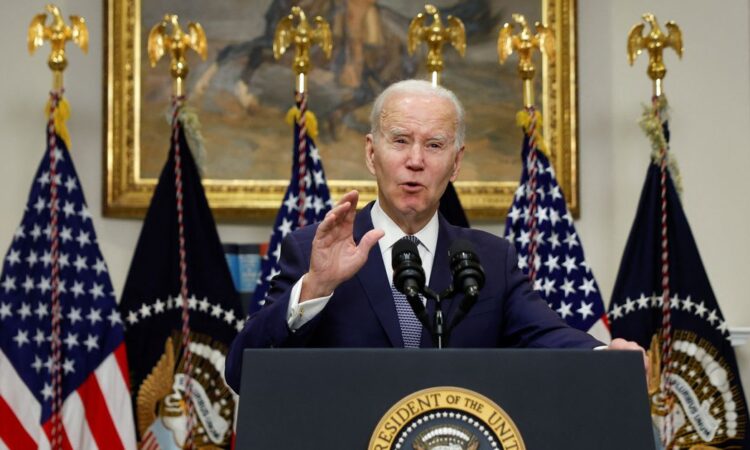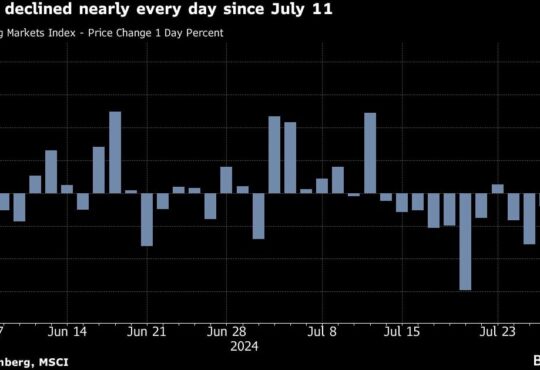
March 13 (Reuters) – U.S. President Joe Biden vowed to do whatever was needed to address a threatened banking crisis after the collapses of Silicon Valley Bank (SIVB.O) and Signature Bank (SBNY.O) forced regulators to step in with emergency measures.
Biden’s attempt to reassure markets and depositors came after weekend moves by the United States to guarantee deposits at collapsed tech-focused lender SVB failed to persuade investors that other banks around the world were healthy.
Monday’s U.S. market open saw First Republic Bank (FRC.N) tumble 65.1% despite news it had secured fresh financing, while Western Alliance Bancorp (WAL.N), PacWest Bancorp (PACW.O) and Charles Schwab (SCHW.N) fell 75.9%, 41.0% and 19%, respectively.
Trading in the stocks was halted several times due to volatility.
Big U.S. banks including JP Morgan Chase (JPM.N), Morgan Stanley (MS.N) and Bank of America (BAC.N) also fell.
Latest Updates
View 2 more stories
The SVB shockwaves were felt in Europe too, where the STOXX banking index (.SX7P) was down 6.3% in its largest one-day fall in more than a year. Germany’s Commerzbank (CBKG.DE) fell as much as 12.7%, while Credit Suisse (CSGN.S) hit a new record low after falling 15%.
Swiss financial regulator FINMA said it was closely monitoring the banks and insurers it oversees and looking for signs of contagion from the collapse of SVB and Signature.
Biden said his administration’s rapid action over the weekend should reassure Americans that the U.S. banking system is safe, adding that he was going to ask Congress and regulators to strengthen bank rules.
“Americans can have confidence that the banking system is safe. Your deposits will be there when you need them.”
In the money markets, a closely-watched indicator of credit risk in the U.S. banking system edged up, as did other indicators of credit risk in the euro zone. Europe’s volatility index (.V2TX) jumped to its highest level since October 2022.
“When a step (is taken) this big, this quickly, your first thought is ‘crisis averted’. But your second thought is, how big was that crisis, how big were the risks that this step had to be taken?” said Rick Meckler, partner at Cherry Lane Investments.
The price of gold meanwhile raced towards the key $1,900 level, emboldened by bets that the U.S. Federal Reserve may have to tone down its rate hikes as investors sought safe havens.
“There is a sense of contagion and where we see a repricing around financials is leading to a repricing across markets,” said Mark Dowding, chief investment officer at BlueBay Asset Management in London.
[1/3] U.S. President Joe Biden delivers remarks on the banking crisis after the collapse of Silicon Valley Bank (SVB) and Signature Bank, in the Roosevelt Room at the White House in Washington, D.C., U.S. March 13, 2023. REUTERS/Evelyn Hockstein
Dowding said he did not think that a lot of the issues affecting U.S. banks would be present in European lenders.
Bonds held by SVB were “worth next to nothing in a short space of time, so against that backdrop, that has an effect that is translated on a more widespread basis,” he added.
U.S. regulators on Sunday stepped in after the collapse of SVB – the largest U.S. bank failure since 2008, which suffered a run after a big hit on a portfolio of bonds.
SVB’s customers will have access to all their deposits starting Monday and regulators set up a new facility to give banks access to emergency funds. The Federal Reserve also made it easier for banks to borrow from it in emergencies.
Regulators moved swiftly too to close New York’s Signature Bank, which had come under pressure in recent days.
EUROPEAN FALLOUT
In Germany, the central bank convened its crisis team on Monday to assess the possible fallout on the local market, even as no emergency action was foreseen in Europe.
After marathon weekend talks, early on Monday in London HSBC HSBA.L said it was buying the British arm of SVB for one pound ($1.21). It said SVB UK had loans of around 5.5 billion pounds and deposits of around 6.7 billion pounds as of March 10.
While SVB UK is small – HSBC’s balance sheet exceeds $2.9 trillion – concerns that SVB’s failure would cause Britain’s start-up industry to seize up had prompted calls from the sector for government intervention.
MARKETS GYRATE
Meanwhile, a furious race to re-price interest rate expectations also sent waves through markets as investors bet the Fed will be reluctant to hike next week.
Traders currently see a 50% chance of no rate hike at the Fed’s meeting next week, with rate cuts priced in for the second half of the year. Earlier last week a 25 basis point hike was fully priced in, with a 70% chance seen of 50 basis points.
Two-year U.S. Treasury yields were last down 55 bps at around 4.09% set for their biggest one day fall since 1987 according to Refinitiv data.
SVB’s collapse comes alongside the closure of crypto-focused bank Silvergate (SI.N), which last week disclosed plans to wind down operations and voluntarily liquidate, in the aftermath of FTX’s implosion last year.
U.S. banks lost more than $100 billion in stock market value late last week following SVB’s failure, while European banks have now lost a similar amount, a Reuters calculation showed.
Reporting by Rae Wee in Singapore and Alun John, Amanda Cooper and Lucy Raitano in London; Additional reporting by Dhara Ranasinghe; Writing by Alexander Smith; Editing by Catherine Evans
Our Standards: The Thomson Reuters Trust Principles.





